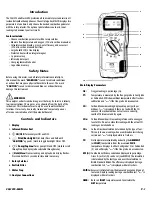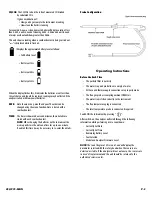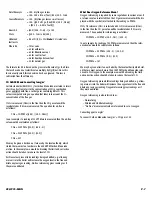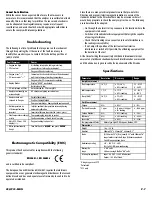
C50/C75-MAN
P. 7
Net efficiency %
= 100 - dry flue gas losses
= 100 - 20.9 x K1n x (Tnet)/K2 x (20.9 - O
2
m)
Gross efficiency %
= 100 - {dry flue gas wet losses}
= 100 - {[20.9 x K1g x (Tnet)/K2 x (20.9 - O2m)]
+ [K3 x (1 + 0.001 x Tnett)]}
Excess Air
= [20.9/(20.9 - O
2
m) - 1] x 100
CO
2
%
= [(20.9 - O
2
m) x K2/20.9]
U n b u r n e d
= K4 x CO/(CO + CO
2
)
Note:
CO scaled in %
fuel loss %
Where K4
= 70 for coke
= 65 for anthracite
= 63 for Bituminous coal
= 62 for coal tar fuel
= 48 for liquid petroleum fuel
= 32 for natural gas
The formula for K4 is based on the gross calorific value Qgr. To obtain
the loss based on net calorific value multiply by Qgr/Qnet. Since this
loss is usually small, this conversion has been ignored. This loss is
subtracted from the efficiency.
CO AIR-FREE and Converting to mg/m
3
Certain standards (ANSI Z21.1) for Carbon Monoxide are stated in terms
of air-free. Air-free refers to the concentration of CO in combustion
gases undiluted with flue, or other gases containing little CO. This
value is computed using an equation that takes into account the O
2
concentration of the flue gas.
If 5% is measured (O2m) in the flue then the CO gas value will be
recalculated as if 0% were measured. The equation for air-free is
as follows:
COa = CO PPM x [(20.9) / (20.9 - O2m)]
In our example if a reading of 325 PPM were measured then the air-free
value would be calculated as follows:
COa = 325 PPM x [(20.9) / (20.9 - 5)]
COa = 325 PPM x [(20.9) / (15.9)]
COa = 427
We may be given a limit on our furnace by the local authority, which
stated that we must not emit more than 400-PPM Carbon Monoxide
air-free. In the example we would be breaking the limit and corrective
action should be taken to reduce the level of CO.
Air-free values prevent false readings being submitted, e.g. allowing
more air into the boiler will increase the oxygen level in the flue and
dilute any toxic gas reading. Air-free referencing gives readings as if
they were undiluted.
What Does Oxygen Reference Mean?
Oxygen referencing is required by some regulations in various areas. if
a reference value is selected then the CO gas measurement will be dis-
played with the symbol (n) attached to the reading i.e. PPMn.
If 3% O2 reference (O2r) is selected and 5% O2 is measured (O2m)
in the flue then the CO gas value will be recalculated as if 3% were
measured. The equation for referencing is as follows:
CO PPMn = CO PPM x (20.9 - O2r) / (20.9 -5)
In our example if a reading of 95 PPM were measured then the refer-
enced value would be calculated as follows:
CO PPMn = 95 PPM x (20.9 - 3) / (20.9 -5)
CO PPMn = 95 PPM x (17.9) / (15.9)
CO PPMn = 107
We may be given a limit on our boiler by the local authority which stat-
ed that we must not emit more than 100 PPM Carbon Monoxide refer-
enced to 3% Oxygen. In the example we would be breaking the limit
and corrective action should be taken to reduce the level of CO.
Oxygen referencing prevents false readings being submitted, e.g. allow-
ing more air into the boiler will increase the oxygen level in the flue and
dilute any toxic gas reading. Oxygen referencing gives readings as if
they were undiluted.
Oxygen referencing is also referred to as:
• Normalizing
• Diluted and Undiluted readings
• “Air Free” measurements when referenced to zero % oxygen
Converting ppm to mg/m
3
To convert Carbon Monoxide to mg/m
3
= CO ppm x 1.25





























